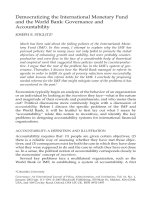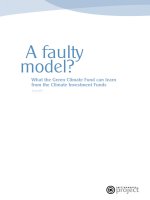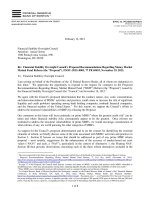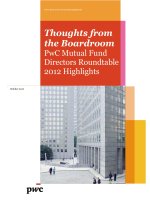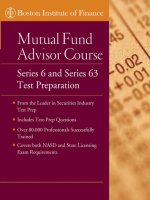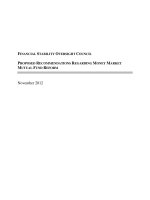baer & gensler - the great mutual fund trap; an investment recovery plan (2002)
Bạn đang xem bản rút gọn của tài liệu. Xem và tải ngay bản đầy đủ của tài liệu tại đây (1 MB, 353 trang )
The Great
Mutual Fund Trap
This book has been optimized for viewing
at a monitor setting of 1024 x 768 pixels.
GREGORY BAER AND GARY GENSLER
Broadway Books | New York
The Great
Mutual Fund Trap
AN INVESTMENT RECOVERY PLAN
the great mutual fund trap. Copyright © 2002 by Gregory Baer and
Gary Gensler. All rights reserved. No part of this book may be reproduced or
transmitted in any form or by any means, electronic or mechanical, including
photocopying, recording, or by any information storage and retrieval system,
without written permission from the publisher.
For information, address Broadway Books,
a division of Random House, Inc., 1540 Broadway, New York, NY 10036.
Broadway Books titles may be purchased for business or promotional use or for
special sales. For information, please write to: Special Markets Department,
Random House, Inc., 1540 Broadway, New York, NY 10036.
broadway books and its logo, a letter B bisected on the diagonal, are trademarks
of Broadway Books, a division of Random House, Inc.
Visit our website at www.broadwaybooks.com
Designed by Chris Welch
Library of Congress Cataloging-in-Publication Data
Baer, Gregory Arthur, 1962–
The great mutual fund trap : an investment recovery plan / Gregory Baer and
Gary Gensler.
p. cm.
Includes bibliographical references and index.
eISBN 0-7679-1073-7
1. Mutual funds—United States. 2. Investments—United States. 3. Investment
analysis—United States. I. Gensler, Gary. II. Title.
HG4930 .B33 2002
332.63'27—dc21
2001056666
v1.0
For the women in our lives
Francesca, Shirley, Anna, Lee, and Isabel
and
the three baers
Jack, Matt, and Tommy.
They give us purpose.
Acknowledgments ix
A Note from the Authors xiii
Introduction: Rediscovering Your Common Sense 1
Part I Investors in Wonderland 9
Chapter 1 Money Management in a Nutshell
13
Chapter 2 And Lead Us Not into Temptation
22
Chapter 3 Risk, Diversification, and Efficient Markets 42
Part II The Great Mutual Fund Trap 59
Chapter 4 The Grim Reality of Poor Performance 65
Chapter 5 The Triumph of Hope over Experience 81
Chapter 6 The Ankle Weights on Running an Actively Managed
Fund 100
Chapter 7 Whose Fund Is It, Anyway? 110
Contents
Part III The Great Stock Picking Hoax 117
Chapter 8 Picking Badly 123
Chapter 9 Time to Call in an Expert 132
Chapter 10 The Darts 148
Chapter 11 The Myth of Technical Analysis 155
Chapter 12 Bad Timing 166
Chapter 13 Why We Draw to Inside Straights and Invest Poorly
170
Part IV Passive Investing for (Less) Fun and (More)
Profit
177
Chapter 14 Index Funds 181
Chapter 15 Exchange-Traded Funds 190
Chapter 16 If You Feel You Must How to Buy Stocks the Right
Way 200
Chapter 17 Breaking Up Is Hard to Do—Moving from Active to Passive
Investing 213
Part V The Empire Strikes Back 219
Chapter 18 New and Improved! 223
Chapter 19 The Great Social Security Heist 233
Part VI The Rest of the Picture 249
Chapter 20 Asset Allocation: A Subject Truly Worth Your Time 253
Chapter 21 Bond Investing 258
Chapter 22 The Benefits of International Stocks 267
Chapter 23 Tax-Advantaged Retirement Investing—Putting Uncle Sam to
Work for You
273
Chapter 24 Saving for College—Tax-Free 284
Conclusion: An Investment Recovery Plan 294
Appendix: How Index Funds Work 299
Notes 303
Bibliography 319
Index 323
viii
Contents
W
e were only able to write The Great Mutual Fund Trap with
the assistance of many other people. In particular, we have
one institution, two companies, and a lot of people to thank.
The institution is the U.S. public library, in particular the Library of
Congress and Fairfax County Library, George Mason branch. If you
haven’t visited a library recently, you may be unaware that on-line data-
bases now allow you to access practically any newspaper or periodical,
going back decades.
Morningstar, Inc.’s comprehensive Principia Pro database is the
source for much of our research on mutual fund performance. Much of
this data is also available on the Morningstar website.
RiskMetrics Group, Inc., is a company dedicated to the measure-
ment of risk, believing as we do that “return is only half the equation.”
At RiskMetrics, Ethan Berman and Greg Elmiger provided great help,
particularly in analyzing the Wall Street Journal’s Dartboard Portfolio.
Daniel Greenberg at James Levine Communications was an able
guide through the maze of publishing, and good company to boot. Jim
Acknowledgments
ix
Levine was good enough to pluck our proposal from the “slush” of un-
solicited manuscripts. For that alone we’ll be forever grateful.
At Broadway Books, Suzanne Oaks, our editor, recognized immedi-
ately what this book was all about. Suzanne and Claire Johnson pro-
vided helpful edits and gentle nudges. When Suzanne moved on to
greener pastures, Trish Medved became our guide, and helped us nego-
tiate the end stages of the process. Rebecca Holland, our production
editor at Broadway, maintained her professionalism and sense of humor
in the face of a barrage of last-minute edits by nervous first-time au-
thors.
We are indebted to our research assistant, Nataliya Mylenko. While
working on her Ph.D. in finance, she spent countless hours researching
historical performance data on hundreds of stocks. Her work provided
the foundation for Chapter 10 on the Wall Street Journal’s stock pick-
ing contests.
Many people, not all of whom are eager to be named, have been kind
enough to review the book and give us comments. Steven Schoenfeld
was an informed and patient guide to the world of exchange-traded
funds and indexing more broadly. Leslie Buckland, Doug Carroll, Stan
Crock, Ed Demarco, Jane Gensler, Bill Grace, Bob Grusky, Bill Lang,
Joe Minarik, Eric Mogilnicki, Peter Orszag, Ronni Rosenfeld, Paul
Sagawa, Alan Summers, Larry Summers, Steven Wallman, and Leslie
Woolley presented valuable review. Arthur Baer reviewed the early
drafts and provided much-needed encouragement. At the earliest
stages, Anna Gensler convinced her dad that he simply had to write
this book. Rob Gensler, a very successful money manager, provided im-
portant support even as his identical twin brother’s project questioned
the very nature of his industry.
We are both fortunate to have married women smarter than our-
selves. Francesca Danieli and Shirley Sagawa were, aside from their
many other contributions, invaluable editors and sounding boards.*
At this point in most acknowledgments, you’ll see the authors note
x Acknowledgments
* Any reader who may happen to be considering establishing a corporate-nonprofit
partnership should consider Common Interest, Common Good: Creating Value Through
Business and Social Sector Partnerships by Shirley Sagawa and Eli Segal (Harvard Busi-
ness School Press, 2000).
that, despite the myriad contributions of others, they are solely respon-
sible for the contents and solely to blame for any errors. Having spent
a few years in politics and government, we aren’t about to fall into that
trap! To anyone wishing to point out mistakes or assign blame, we say,
“Haven’t we had enough of the politics of personal destruction? Have
you no decency?” That and, “We’re sorry.”
Acknowledgments xi
Y
ou may wonder why two guys like us would write a book about
personal investing. We don’t have any business to promote. We’re
not financial planners or brokers. Furthermore, given the things
we have to say about the current state of money management, we’re un-
likely to make a whole lot of new friends. So why?
Initially, the reason was frustration. While serving at the Treasury
Department during the Clinton administration, we undertook a review
of the investment performance of the Pension Benefit Guaranty Cor-
poration. The PBGC is the federal government entity that stands be-
hind the corporate pensions of millions of American workers. It had
been actively investing in stocks—that is, hiring managers to beat the
market—since 1976. The performance was remarkably poor. A dollar
invested by PBGC in 1976 would have returned 44 percent more by
2000 if it had simply tracked the market. Moreover, the PBGC earned
these below-market returns while investing in stocks that were more
risky than those in the broad market.
While the size of the lost earnings surprised us, the nature of the
problem did not. While at Goldman, Sachs, Gary would often be asked
A Note from
the Authors
xiii
for stock-picking advice. He always responded that passive investment
was the best option, though his friends and family mistakenly thought
he was being coy. While working at the Federal Reserve, Greg had
some of the nation’s best economists explain to him the folly of trying
to beat the market. To our chagrin, though, we discovered that not
everyone was inclined to see it this way. Our efforts to effect reform at
the PBGC were successfully blocked by those with a vested interest in
the existing system.
We therefore felt the urge to alert consumers to the traps awaiting
them in financial markets. We knew that the average individual in-
vestor was probably paying more for active fund management than the
PBGC and faring even worse. That said, we wouldn’t have written this
book if there were not good alternatives to the current system. Fortu-
nately, we knew of wonderful new opportunities for investors to im-
prove returns and diminish risks—opportunities that we believe most
investors don’t yet fully appreciate. So, we offer The Great Mutual Fund
Trap as both a revealing look into the current system’s failings and a
promise of a better way.
We hope that as you read on, you’ll have a few laughs and enjoy the
everyday examples we use to illustrate complex financial concepts. We
think investing books should be fun and interesting. That does not
mean, though, that we believe investing itself should be fun. Interest-
ing, yes, fascinating maybe, but to us “fun” is finishing work on your fi-
nances in time to throw the ball with your kids or read a good novel or
call an old friend on the phone. Here’s a good rule of thumb: if you’re
having fun investing, then there’s a good chance that you’re not prop-
erly diversified, you’re trading too much, and you’re taking too much
risk.
—Greg Baer and Gary Gensler
xiv A Note from the Authors
The Great
Mutual Fund Trap
Introduction
Rediscovering Your
Common Sense
T
his book is written for the millions of Americans who invest in
the stock or bond market to help achieve their long-term finan-
cial goals—a home, a college education for their children, a se-
cure retirement. We believe that the vast majority of these investors are
investing the wrong way—paying billions of dollars in unnecessary
costs and running needless risks in a quest to outperform the market.
Why are so many people wasting so much money? By making the
perfectly understandable mistake of trusting the experts.
The Trap
As Americans, we have the benefit of expert advice in almost all aspects
of our lives. Thanks to the wonders of capitalism, we can find a cardi-
ologist to advise us on our hearts, a computer consultant to advise us on
our computer, or even a wedding planner to advise us on how and
where to get married. We take for granted that for almost any decision,
major or minor, we can obtain and benefit from expert advice.
The meek may inherit the earth, but they won’t get the ball
from me.—Charles Barkley, professional basketball player
1
Therefore, as individuals decide how to invest, they naturally look to
the experts. Investors cede control of their investments to mutual fund
managers, brokers, or financial planners. They pick their own stocks af-
ter hearing the latest advice from Wall Street analysts and economists.
They trust that the fees they are charged are fair and that the advice
they obtain is sound.
In the great majority of cases, however, expert money management
advice simply leads investors to underperform the market and enrich
Wall Street. Investors should pay nothing for it, either directly or indi-
rectly.
For example, Americans currently have over $3 trillion invested in
actively managed stock mutual funds—that is, funds whose managers
pick stocks in an attempt to beat the stock market’s overall perfor-
mance. They have another $800 million invested in actively managed
bond funds. These mutual funds are held by investors directly or in bro-
kerage accounts, 401(k)s, IRAs, or variable annuities. Experience clearly
shows that fund managers’ stock and bond picking abilities usually fall short
of their considerable fee-imposing abilities. That’s entirely predictable,
given that the mutual fund companies run up at least $70 billion per
year in costs for investors in their attempts to beat the market.
Other investors are buying stocks on their own or through invest-
ment clubs, frequently turning over their entire portfolios each year as
they jump from one investment to another. Their reasons may include
recommendations from brokers and the media or an interview or report
about a “hot” new sector. These are poor ways to choose stocks and great
ways to increase risk unnecessarily.
So, why do so many people keep investing in ways the evidence
shows is counterproductive? We believe that there are four simple an-
swers.
First, we are by nature optimistic and confident. We are all too will-
ing to believe that poor past experience will reverse itself or in the fu-
ture apply only to other people.
Second, our optimism and overconfidence are reinforced by a con-
stant, consistent message from the financial industry and the financial
media: try to beat the market. The message can be direct, even crass, as
when a TV commercial promises that frequent stock trading will earn
2 Introduction
you a Caribbean island of your own. More effective, though, is the sub-
tle message conveyed by a constant parade of money managers and an-
alysts, all promising that they have identified a winning stock that is
sure to outperform the market. To seize this opportunity, of course, you
must buy their fund or trade with a broker.
Third, we tend to focus on returns and ignore the costs of investing.
You probably know about how much you pay each month for electric-
ity, housing, and other services. If you’re like most people, though,
you’ve never totaled up your costs of investing—all of them, including
management fees, transaction costs, and taxes.
There’s a reason you don’t consider the costs of investing, of course.
Mutual funds and brokers have constructed a system where the costs
are practically invisible. You had to write a check to your electric utility
or mortgage company, but you’ve never paid a bill for brokerage or mu-
tual fund management. Such costs are simply deducted from your an-
nual mutual fund returns or taken off the top when a broker executes
your trades. You don’t notice when 1 percent disappears here, 2 percent
there, particularly when your investments are making money. How else
can you explain the fact that many Americans react furiously to the
$1.50 ATM surcharges they pay, on average, fifty times per year ($75),
yet don’t utter a peep when they pay a 5 percent sales load on a $10,000
mutual fund investment ($500)?
Fourth, investors do not understand how markets work, and how
very difficult it is to beat them consistently, even by a little bit. The best
analogy we can think of is about betting on sports. Don’t worry, even if
you don’t care about sports or betting, we promise you’ll be able to fol-
low it.
Every fall weekend, there are about three hundred college football
games. Picking who will win those games unquestionably involves skill.
Those who have the time and ability to research the recent records and
players of each team will do better than those who do not. While some
games will be hard to pick, others will not. A little research will show,
for example, that Notre Dame has always beaten Navy, and Florida
State has always beaten Duke. In other cases, even where the teams his-
torically have been more evenly matched, one team may have far better
athletes in a particular season. Because there are a lot of lopsided games
Introduction 3
like these each weekend, the average fan can probably pick winners
about, say, 60 percent of the time. Someone who does it full-time can
probably get 70 percent or more right.
When individual investors think about picking stocks, this is how
most imagine it. They believe that they can do research on the past per-
formance and current management of companies and pick winning
companies a majority of the time. Or they believe they can give their
money to an expert money manager who probably can do even better,
in exchange for a fee.
Here is the reality. Every fall weekend, sports handicappers in Las
Vegas establish a point spread for each college football game. To reduce
their risk, bookies need equal amounts bet on each team. Giving
“points” to gamblers who bet on the underdog is the best way to ac-
complish this goal. Otherwise, no one would bet on Navy or Duke. In
reality, then, sports gamblers do not have the option of simply picking
Notre Dame or Florida State to win. They must pick them to win by
more than twenty points or some similar spread. That’s the price of
Notre Dame’s or Florida State’s past performance and current talent.
Because handicappers know their business well, someone who bets on
college football games over time will rarely pick more (or less) than 50
percent of games correctly. And because bookies charge gamblers a per-
centage of any winnings—requiring them to pay $11 to bet $10—the
average gambler is almost certain to be a long-term loser. (The book-
ies, of course, make money whether you win or lose.)
The reality for individual investors who pick stocks or have money
managers pick for them is much the same. They do not get to buy a pop-
ular stock at the price at which it was originally issued and share in all the
earnings. Rather, they must pay something akin to a point spread—most
frequently expressed as a price-to-earnings ratio. Just as bettors must of-
ten give twenty points to bet on Florida State, investors often must spend
$30 or more to buy $1 of projected earnings for a company that is a
proven winner. The market has already priced the company’s past per-
formance and managerial talent into the price of the stock. And of course
investors have to pay Wall Street to execute the trade or manage their
money. That means that over time most investors underperform the mar-
ket. (The fund managers and brokers, like the bookies, make money
whether you win or lose.)
4 Introduction
Here’s a wonderfully self-serving explanation of how sports betting
works, taken from an on-line gambling site.
1
Just by flipping a coin you will be right 50 percent of the time. At
odds of 10/11 [the standard odds with a bookie], only 52.4 per-
cent of your bets have to win for you to overcome the bookmaker’s
profit and break even, so you only need a very small edge to be-
come a winner. Do your homework, bet selectively and 55 percent
winning bets is definitely achievable. Even 60–65 percent is a re-
alistic target. At those levels you will have an extremely profitable,
as well as enjoyable hobby.
The ad’s promise is preposterous. Sports betting is not an “extremely
profitable” hobby for Americans. At best, it’s moderately expensive en-
tertainment. At worst, it’s a self-destructive addiction. But notice how
easy it is to say that you have to be right “only 52.4 percent” of the time.
With average annual costs not far from 2.4 percent, the mutual fund indus-
try is sending a very similar message.
In the chapters that follow, we will take a look at just about every
market-beating strategy you can think of, including:
• buying mutual funds with good past-year performance
• buying mutual funds with good past-decade performance
• buying stocks with consensus “buy” recommendations from ana-
lysts
• buying stocks recommended by investment newsletters
• buying the Dogs of the Dow
• buying Morningstar five-star funds
The bottom line: they just plain don’t work. Moreover, there are
good reasons why you should never have expected them to work.
Managing Escape
So, what’s an investor to do?
You cannot improve your returns by spending more time or money
Introduction 5
trying to pick funds or stocks. Double the time you spend researching
funds and stocks, and your returns will not change. Add a financial ad-
viser, a subscription to an investment newsletter, or a high-load fund,
and your returns will shrink by the amounts you pay for the service.
You can, however, significantly improve your returns by improving
the vehicles through which you invest. You can improve your returns by
choosing vehicles that offer the lowest possible costs and the greatest
tax efficiency. You can reduce your risk by choosing vehicles that diver-
sify your portfolio.
The good news is that financial products have emerged that allow
you to achieve these goals through passive investing. By passive invest-
ing, we mean attempting to duplicate the returns of the market at the
lowest possible cost. For stock investors, passive investing means buy-
ing and holding a broad array of stocks in their proportion to the over-
all market, rather than buying only those stocks you believe are likely to
outperform the market.
• The first product was the invention of index mutual funds. Index
funds allow you to invest in the broad stock market at low cost.
Index funds for large, institutional investors have been around
since 1971, but they have only started to capture the attention of
individual investors in the past ten years. They are still underap-
preciated and underutilized as a tool for individual investors. For
most investors, they represent the best way to avoid the trap and
achieve higher returns with lesser risk.
• The second innovation is the very recent emergence of exchange-
traded index funds, which hold the same assets as stock index
funds but trade like stocks. ETFs can offer marginally lower costs
and substantially better tax consequences than index funds.
• The third innovation is what we’ll call discount portfolio invest-
ing. For those who feel they must buy stocks directly, this vehicle
allows them to buy baskets of stocks at costs close to those of an
index mutual fund.
• The fourth innovation is the democratization of the bond mar-
ket. You can now buy many types of bonds without incurring the
substantial, and generally undisclosed, transaction costs that have
made direct purchases difficult in the past.
6 Introduction
• The fifth innovation is the democratization of risk manage-
ment, allowing individual investors to manage their risks using
some of the same sophisticated tools as brokerage firms.
• The sixth innovation, courtesy of the federal government, is the
creation of genuinely tax-free education savings accounts. Start-
ing in 2002, you can invest in a so-called “529 plan” and never pay
taxes on any of the earnings.
Considering the Stakes
Embarking on a cost-reduction program may not seem as exciting as
the latest market-beating strategy, but do not underestimate the stakes.
A lifetime of monthly investments in a passive account can yield nearly
twice as much as the same amounts actively invested. Assume, for ex-
ample, that you’re investing $250 per month ($3,000 per year) and that
you can expect to earn 8 percent annually after the cost of passive in-
vesting. You end up with a retirement nest egg of about $872,000. Ac-
tively pursue the same goal and you’ll end up earning at least 2 percent
less per year on average, or $497,000 in all. Because of costs and com-
pounding, you will have forgone fully 43 percent of your potential fu-
ture retirement money. (As we’ll see, the reality of fees and costs is
actually a little worse.)
Introduction 7
Getting Started
Improving your returns and reducing your risk will require you to ques-
tion a lot of what you know, tune out a lot of what you hear, and rein-
vigorate your common sense. Now seems like a good time to start.
The Bite of Active Investing
Forgone Earnings
($375,000)
43%
Your Retirement
Money After Active
Investment
($497,000)
57%
8 Introduction
